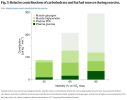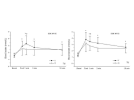Oh that is neat I think this is the first time we fundamentally disagree on something
@North Coast Miller. I think my opinion is more in line with
@bluejeff 's .
I'd like to add a few caveats to my explanations below before I start:
- I have never studied biochemistry / biology and my background is in a completely unrelated STEM field. I am just a curious dude who likes learning stuff.
- My knee-jerk reaction to whether or not metabolic stress is higher in isos vs traditional resistance training is almost the opposite of your position. I believe that isometric produces similar metabolic byproducts than regular resistance training and the difference between the two might not really be that important . If anything, there are good reasons to believe that isos might actually produce more metabolic stress than regular training.
- My main focus of interest has been endurance training for a long time and a lot of what I learned about exercise physiology (lactate, energy production, mitochondrial adaptations, etc.) comes from this point of view. From an endurance training perspective, people usually come at this from the exact opposite side where maximizing fat oxidation and producing the least amount of metabolic stress as possible is the end goal.
Now let me explain why metabolic stress might actually be higher than regular training.
During exercise, there are mostly 3 ways of generating energy, either we breakdown Phosphocreatine (PCR) to generate ATP (anaerobic alactic), we burn glucose during Glycolysis (either anaerobically or aerobically) or we break down fats (aerobically). These 3 ways always coexist on a spectrum where you never fully turn off one or the other, your body usually turns the knobs more or less depending on the intensity of the exercise and the energy required. Note that my explanations are quite simplified because reality gets way more complex and messy. I am also not gonna talk about how lactate can be reused as a fuel or other pretty niche fuel sources like ketones or amino acids. And I won't really mention how PCR is resynthesized.
Usually, as a rule of thumb you can view the PCR system as the fastest way to generate ATP and fat oxidation as the slowest. In this order: PCR => Anaerobic Glycolysis => Aerobic Glycolysis => Fat oxidation.
We know that anaerobic glycolysis (also called anaerobic lactic energy system) results in negative byproducts. At first, byproducts like lactate and hydrogen ions appear in the muscle locally and the muscle can keep clearing them by itself. If the intensity of the exercise is too great and the duration too long, the muscle can't keep up and the byproducts end up in the blood for the rest of the body to clear (that is why we breathe harder among other things, not just because we need more oxygen but also to get rid of some byproducts). That is what makes things like lactate raise in the blood during exercise.
So far so good, that is nothing new. Here is where we start to disagree:
The rhythmic contract and relax is big part of what generates glucose turnover in the muscle - what's there might be mostly consumed but I'm agnostic on how much more is happening in the absence of more dynamic movement or contraction. I am likewise ignorant of just how much turnover is needed to cross the threshold.
One thing that I have always hated about energy systems discussions in general is that it might just be me but I feel like there is always a missing step in most people's explanations. When you eat carbohydrates your digestive system breaks down the carbs and absorbs them as glycogen in the liver and the muscles. When you start exercising, if your body needs energy quickly you are gonna start to quickly break glucose into ATP during glycolysis.
But wait, where is that glucose coming from? I thought we were talking about glycogen, what happened to it? Well, when you exercise your liver breaks down that glycogen into glucose and releases it in the blood to provide the muscles with an extra boost. That is absolutely true and provides a good source of energy during endurance sports for example (unrelated but cool fact, that is why pro cyclist are consuming up to 120 g of sugar per hour nowadays!). But, the big thing missing is what happened to the muscle glycogen?
It appears that muscle glycogen becomes more and more important the more intense the exercise becomes. Here is a great
review that explains all of what I said earlier much better. It goes in details about the different energy substrates used during exercise. Here is a relevant snippet:
During very intense efforts lasting seconds (such as throws, jumps or 100- to 400-m sprints) or during intermittent game activities and field sports, most ATP is derived from the breakdown of phosphocreatine (PCr) and glycogen to lactate. Direct measurements of muscle PCr and glycogen before, during and after such exercise bouts show substantial decreases in the levels of these substrates
And here is figure 3 which is quite relevant for our purpose here:

We can see how the higher the exercise intensity, the higher the contribution from muscle glycogen as opposed to plasma glucose. Now I know that this is an example of endurance sports where they only reached 85 % of VO2max, but resistance training goes at much higher intensity for the muscle worked and is not sustainable for a long time. The muscles worked during resistance training need even more energy and they need it quickly. That energy needs to come from somewhere which is primarily muscle glycogen through glycolysis and not through blood glucose levels.
So blood glucose is not the primary source of energy during resistance exercise and muscle glycogen is. But there still is the question about whether or not that muscle glycogen is used aerobically or anaerobically. If it was used mostly aerobically, then in that case isometrics would not produce a lot of metabolic byproducts.
(By the way just like you I have not found any relevant study on this subject, this is so niche that I understand lol)
Despite not finding any relevant studies, I think we can still make an educated guess on whether or not isometrics causes more metabolic stress than regular training. We know that isometric contractions basically cuts off all the blood from coming in or out of the muscle. That means that the byproducts from anaerobic glycolysis can't get out of the muscle until the muscle relaxes. But it also means that new oxygen cannot get in. If all the oxygen is consumed, the muscle is only left with anaerobic energy systems. Hence why if anything there are good reasons to believe that isos might actually produce more metabolic stress than traditional resistance training.
So in summary, lactate and other metabolic stress markers raise with both exercise intensity and with exercise duration. This happens in traditional resistance training, in endurance training but also in
isometric training :

I have maintained what most folks would consider a goodly amount of muscle using only iso, presumably someone fairly light could use it to gain mass. But at some point the lack of metabolic turnover def seems to hurt hypertrophy. When I crested 200lbs, gaining 10lbs in just over 3 months, was using iso with sprint in place intervals.
Which isn't to say there is no hypertrophy even from static iso training of relatively short efforts. The pulses def produce some turnover and a bit of blood occlusion, and a newbie will almost certainly put on some muscle.
This is one of those cases where n=1's are really hard to generalize. Results are hard to dispute and personal experience is for sure important. But this is one of those things where it is hard to truly know for sure the impact of one training variable over the other. It feels almost impossible to truly control everything in an experiment.
For example I can anecdotally confirm that I too managed to gain a lot of muscle mass with only isometric training without directly trying to raise systemic lactate (though it probably did anyways). I tracked my weight progression and got the heaviest I have ever been where I gained 14 lbs in just 4 months and a lot of it was muscle mass. Then I cut, rebulked, and recut to try and make sure that my weight comparison was fair from the beginning of the experiment the end. After 13 months I am fairly confident that I gained 15 lbs of muscle mass in a year (if anything I think I am less fat now but this is highly subjective and debatable). With all that being said, I would not be surprised if someone managed to gain significant muscle mass by doing only extreme isos provided that they keep reaching true failure and that the load is significantly high.
Honestly this is one of those cases where if you found something that works, I really don't see any reasons to change it, especially when as you said you can also gain some HIIT-esque benefits. In my book that is definitely a win.
(Sorry for it being that long! I did not really expect to write that much lol! I hope someone still managed to read the whole thing

).


